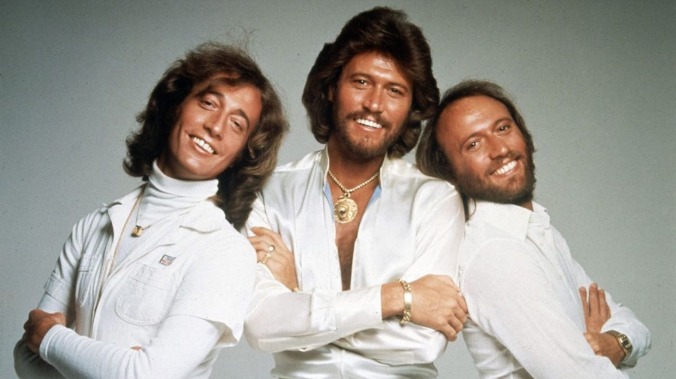The Bee Gees—an Australian-by-way-of-England pop group that featured Gibb brothers Barry, Robin, and Maurice—are one of the best-selling bands ever to exist, trailing only The Beatles and The Supremes in lifetime Billboard sales. Deemed the “godfathers of disco,” they dominated the charts in the late ’70s following their contributions to the blockbuster 1977 Saturday Night Fever soundtrack.
There’s so much more to their story than disco, though. Years before Fever, the determined brothers found success thanks to their prolific output of poignant pop hits—like “Massachusetts” and “To Love Somebody”—featuring their angelic three-part harmonies. A quick rush to fame at the end of the ’60s led to sibling competition that caused the band to break up for two years; when they got back together, they faced an uphill battle to become relevant again. They were on the top of the world during the disco era, but when that dance craze fell out of favor, they found themselves right back where they started (with piles and piles of money, but still).
It’s a fascinating, unprecedented story in the history of pop music, which makes it rather surprising that it’s taken this long to be documented. Frank Marshall is best-known as the producer of Oscar bait like Seabiscuit and The Curious Case Of Benjamin Button and box-office hits like Raiders Of The Lost Ark and Jurassic World. His directing credits aren’t as illustrious (Arachnophobia, Congo), but he goes back behind the camera here, aided by mounds of vintage footage and interviews with the brothers and band members. (Only Barry, 74, is still alive, living in Miami.)
For the talking-head interviews, besides the Bee Gees themselves, Marshall features a number of contemporary artists. Noel Gallagher and Nick Jonas, who both know from performing with their brothers, discuss the difficulties involved; Gallagher calls the fraternal tie in a band both its greatest strength and greatest weakness (and he should know). Justin Timberlake enthuses that the Bee Gees would use their own vocals to punctuate where another band might use a horn section. “Uptown Funk”’s Mark Ronson talks about going out to buy every version of “To Love Somebody” he could find, from Nina Simone’s to Janis Joplin’s to The Animals’, but no one was able to equal Barry’s heartrending vocals. Fellow bandmates and producers describe the genesis of some of the most familiar sounds in pop music: the blackout that led to the brothers writing their first single, “New York Mining Disaster 1941”; the first appearance of the Bee Gees’ signature falsetto in “Nights On Broadway”; the recycled drum loop on “Stayin’ Alive.”
The doc’s examination of the band’s creative process contains some of its most riveting moments: The brothers would write in the studio, with Maurice serving as the bridge between singer-songwriters Robin and Barry, enabling a kind of psychic sibling ability to gather the disparate elements of a song together. Once the melodies were intact, their vocals would send the tracks over like no other group’s could: Their combined voices sounded like one voice, only more powerful. “When you’ve got brothers singing, it’s like an instrument that nobody else can buy,” Gallagher says. Marshall wisely puts the music front and center, and it’s hard not to be wowed by the unfurling of one spectacular song after another. The group’s skyrocketing fame is not surprising to witness—not even the second time around—but a bit jaw-dropping all the same. “I had six Rolls Royces before I was 21,” Maurice remembers. “I don’t know where they are now, but that’s how crazy it was.”
If the doc has any flaws, it’s that it’s a bit too fawning of its luminary subjects. Barry discusses how his not being able to perform without a drink or a pill became the battle of the band, with no real follow-up on how that affected them all. “We all did things to each other that I think we’re all sorry for,” he remembers, with no elaboration. No mention is made of the brothers’ ill-fated 1978 cinematic outing, Sgt. Pepper’s Lonely Hearts Club Band, and Lulu is Maurice’s wife until suddenly she isn’t and his new bride Yvonne is introduced. The fraternal tension and competition between Robin and Barry is about as dark as it gets, along with a futile attempt by Maurice to get younger Gibb brother Andy, who died of a heart condition brought on by his cocaine use, to realize how much his drug addiction could cost him.
What actually gets a bit too much screen time is the destruction of disco to explain The Bee Gees’ descent: Radio DJ Steve Dahl’s Disco Demolition at Comiskey Park (as the band was on the biggest tour of its career), rock stars like Alice Cooper and Mick Fleetwood deriding the genre, and a really painful segment highlighting Rick Dees’ “Disco Duck.” It’s an astonishing fall after so much success, but after some time spent wound-licking, the chameleonic Bee Gees rebounded yet again thanks to a call from Barbra Streisand, writing hits for her and other artists like Dionne Warwick, Diana Ross, Kenny Rogers and Dolly Parton, and Celine Dion.
Hopefully, How Can You Mend A Broken Heart will help flesh out the band’s legacy past the flashy disco era that often overshadows it, explaining why current pop stars as well as many fans still revere the band’s music as some of the best ever made. But the bittersweet takeaway from the documentary is Barry, the surviving Gibb brother, left behind to carry on the brothers’ work and keep those memories intact. Even after living a musical life most bands could only dream of, he says, “I’d rather have them all back here and no hits at all.”



 Keep scrolling for more great stories from A.V. Club.
Keep scrolling for more great stories from A.V. Club.